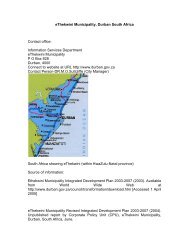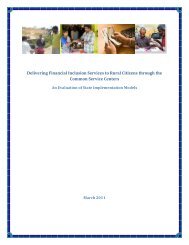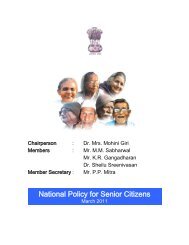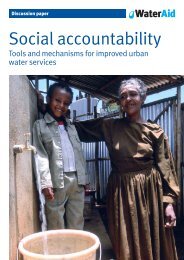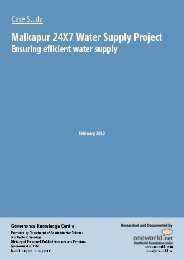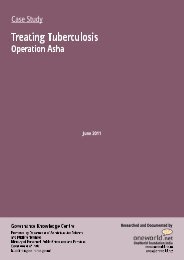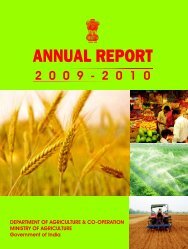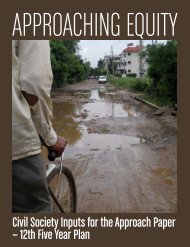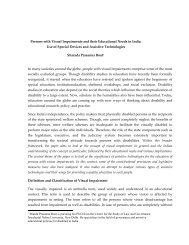Changing Framework of Local Governance and - Create
Changing Framework of Local Governance and - Create
Changing Framework of Local Governance and - Create
You also want an ePaper? Increase the reach of your titles
YUMPU automatically turns print PDFs into web optimized ePapers that Google loves.
<strong>Changing</strong> <strong>Framework</strong> <strong>of</strong> <strong>Local</strong> <strong>Governance</strong> <strong>and</strong> Community Participation in Elementary Education7. Linking <strong>Local</strong> Management <strong>of</strong> Schools with Access <strong>and</strong> ParticipationAttempts to bring schools <strong>and</strong> communities closer together has meant that increasing emphasishas been given to such bodies as Village Education Committees, Parents Teacher Associations<strong>and</strong> Mother Teacher Associations. State Governments have <strong>of</strong>ficially defined the roles <strong>and</strong>responsibilities <strong>of</strong> VECs or other similar bodies. Research (Ramach<strong>and</strong>ran, 2001, Govinda <strong>and</strong>Diwan, 2003) indicates that that school functioning has improved significantly in places wherecommunities have been involved actively. This section intends to examine how localgovernance has impacted on access <strong>and</strong> schooling participation <strong>of</strong> children. One <strong>of</strong> the majorstrategies with this respect has been increasing involvement <strong>of</strong> communities which isconsidered as key to local governance. The following section elaborates upon this issue atgreater length.There are a number <strong>of</strong> examples <strong>of</strong> how communities can <strong>and</strong> have been involved in schoolingin India. In most states, evidence is found that VECs are involved in a variety <strong>of</strong> activitiesranging from kalajatha (cultural programmes for awareness generation <strong>of</strong> the importance <strong>of</strong>education <strong>of</strong> children, about different educational programme, <strong>and</strong> different schemes availablefor incentives etc.), VEC fairs, parental counselling, <strong>and</strong> community events for parentalmotivation. In some states, VECs are responsible for mobilizing <strong>and</strong> utilizing funds availablefrom the government as well as from other sources. Under SSA, VECs in consultation withschool authorities decide how to use school grants for the development <strong>of</strong> schools. There aremany instances where community members have been involved in volunteer teaching <strong>and</strong>Teaching Learning Materials (TLM) preparation in addition to monitoring regular attendance<strong>of</strong> teachers <strong>and</strong> students. Special programmes such as praveshotsav or enrolment drive, mabetimela (mother-daughter fair) <strong>and</strong> teleconferencing have helped organize communitiesaround schooling <strong>and</strong> also for creating dem<strong>and</strong> for education. This has been particularly usefulin promoting participation <strong>of</strong> girls in schooling (Ramach<strong>and</strong>ran, 2001:5).The involvement <strong>of</strong> Mother Teacher Associations in the functioning <strong>of</strong> schools was part <strong>of</strong> theDPEP <strong>and</strong> in many states MTAs have started playing active role (Ramach<strong>and</strong>ran, 2001). Forexample, in Himachal Pradesh MTAs were found actively involved in many villages leadingto improvement in attendance <strong>and</strong> performance <strong>of</strong> children. Recently local school managementbodies have also been taking part in cooking <strong>and</strong> the distribution <strong>of</strong> mid-day meal in manystates. In some States, women motivator groups have been mobilized to promote girls’education. In Maharashtra, Sahayoginis 28 are appointed for a cluster <strong>of</strong> schools <strong>and</strong> in MadhyaPradesh Sahayoginis are appointed in each block (Ramach<strong>and</strong>ran, 2004). Most states haveencouraged alternative schools to enable out <strong>of</strong> school girls to access basic education. Thesespecial programmes run with community support are also part <strong>of</strong> the larger strategy tomobilize the community (Ramach<strong>and</strong>ran, 2001:5). Also a special package has been designedunder SSA called the National Programme for the Education <strong>of</strong> Girls at the Elementary Level(NPEGEL) to reduce the gender gap in the blocks identified as educationally backward interms <strong>of</strong> women’s education. In view <strong>of</strong> the varying situation in gender relations that isattributed to social <strong>and</strong> cultural norms operating within a specific area, community supportseems to be the most essential ingredient for running this programme.Women’s participation in local governance remains a critical concern across the states asgenerally their representation <strong>and</strong> effective participation even in panchayat meetings <strong>and</strong>28 Women animators who can establish a link between community <strong>and</strong> school to promote girls’ education26




